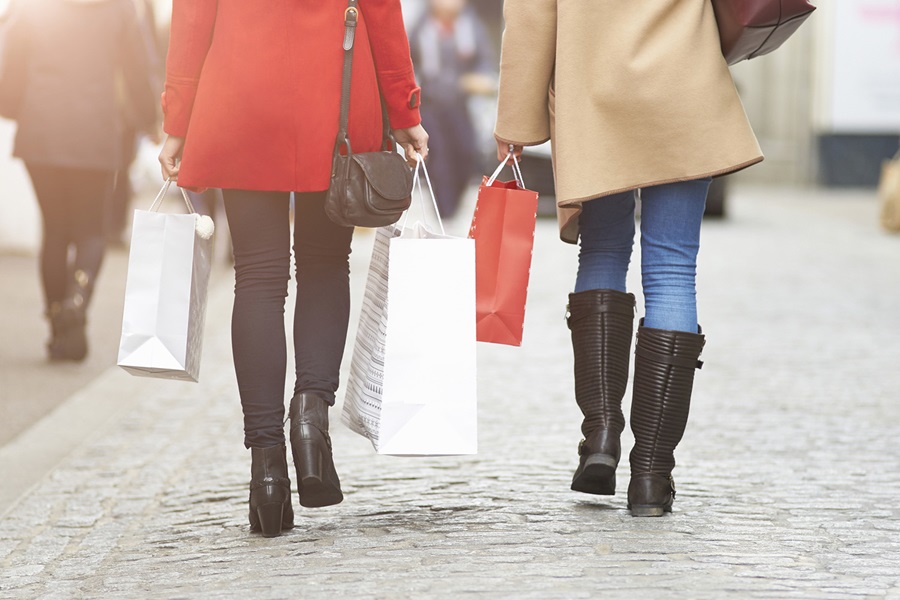As high streets, shopping centres and retail parks across England reopened their doors on 12 April after more than three months of lockdown, we saw £4.4 billion spent by shoppers in the first week alone. Fuelled by pent up demand, consumers having more savings in the bank, and longer store opening hours, we saw spend grow 32% compared to the week before – a notable improvement on the 14% growth when shops re-opened after the first lockdown last June2. We also saw a more even distribution of growth in spend across all demographics, suggesting older shoppers are more confident heading in store as the vaccination roll out continues.
Despite the strong start though, for a number of sectors, the road back to pre-pandemic levels of footfall and spend will be a slow one. It will be important for high street retailers to respond to the consumer behaviours which have developed over the past year and understand which ones could be here to stay.
Getting back to our favourites
When we spoke to consumers earlier this year about what they were looking forward to, top of their lists was socialising with friends (61%), followed by the reopening of restaurants (50%), hairdressers/barbers (45%) and non-essential retail stores (44%).1
In reality, the pace at which we’ve resumed these highly anticipated activities has been a result of balancing what we’d like to do with what’s possible – and how comfortable we feel doing them. Shoppers missing the simple pleasures in life have been out in force, helping family restaurants, such as Toby’s Carvery, perform very well in May3. However, looking at restaurants more broadly, the limitations imposed by social distancing meant that takings were only around 50-60% of their equivalent in 2019. Hairdressers were one of the fastest-growing areas in terms of spend, but again only returned to around 70% of pre-COVID trading as a result of the practical limitations of social distancing in salons and changes in consumers’ grooming habits2,4.
Among non-essential retailers, customers rushed back to those categories they have missed interacting with during the closures, as well as those where they value the in-store experience and ability to make shopping decisions in person. Sales in entertainment stores, and toy and hobby retailers were 78% higher than in the equivalent week in 2019 as shoppers returned to with their favourite categories and retailers2.
Clothing specialists also had a strong first week, with high street fashion taking £462m in bricks and mortar stores – 50% more than in 2019 – as shoppers refreshed their wardrobes in preparation for socialising and the warmer months2. Perhaps surprisingly, online seems to have regained ground faster than last autumn, perhaps as the poor weather and COVID-19 protection measures in-store deterred some shoppers from shopping in physical retailers. We also saw signs that customers were happy to spend a little extra, with higher spend per trip and higher-end shops selling designer fashion brands, toiletries and jewellery performing strongly2,3. This demonstrates there’s still a role for added value in-store experiences and products.
On the other side of the coin, we saw some of the categories that had a winning streak during lockdowns take more of a back seat to the non-essential retailers. Spend in DIY, hardware stores and garden centres declined between 10% and 20% in the second half of April compared to last year , as shoppers’ attentions were diverted away from their home life, an effect which was compounded by the poor weather. Also front of mind for consumers were outdoor activities and holiday plans, resulting in strong sales in cycle specialists and outdoor pursuits stores as many prepared for domestic holidays booked in favour of travelling abroad3,4.
Staying local, shopping local
Our daily lives and routines started to change following the relaxation of lockdown restrictions, and the average shopper made two more trips a week on average4 – a marked shift from the larger, less frequent shops which were a hallmark of the past year.
Sales in the supermarkets and the large bargain stores like Home Bargains and B&M declined between 8% and 10%. This drop was largely driven by shoppers visiting large format stores less often and, conversely, convenience supermarkets benefited from higher footfall which boosted sales at these retailers by 2% compared with the same period in 2019 as the “top up shop” showed signs of returning4.
We continued to see shoppers supporting their local communities, with independent grocery shops, bakers, butchers, delis and farm shops all trading well ahead of pre-pandemic levels. Other signs of Brits supporting local businesses include the fact that charity shops are doing particularly well, perhaps down to a build-up of donations and higher levels of footfall along the high street, particularly in local neighbourhoods. The city centres continued to struggle as commuters return at a slow pace and shoppers favour locations most easily accessible by car or on foot4,5.
All of the early indications show an encouraging resurgence of consumer confidence and a clear desire for physical shopping experiences. Time will tell how demand returns over the coming months but as we get back to normality, retailers should be looking ahead to what role they can play in helping consumers continue to return to the most important things they’ve missed in their lives and how to deliver these in a relevant and engaging way.
Notes:
- Kantar, Worldpanel Plus, survey of 69,376 shoppers, 4 – 10 March 2021
- Kantar, Worldpanel Plus, Physical data, weekly data to 2 May 2021
- Kantar, Worldpanel Plus, Daily Data to 19 May
- Kantar, Worldpanel Plus, Physical data, 3 weeks ending 2 May 2021
- Transport use during the coronavirus (COVID-19) pandemic, Department for Transport, 2 June 2021


